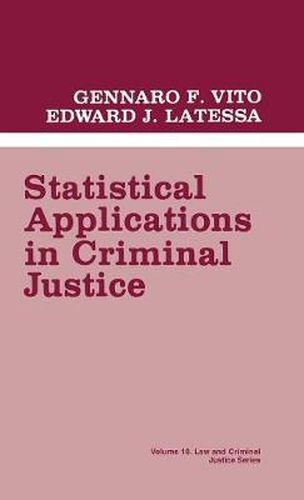Readings Newsletter
Become a Readings Member to make your shopping experience even easier.
Sign in or sign up for free!
You’re not far away from qualifying for FREE standard shipping within Australia
You’ve qualified for FREE standard shipping within Australia
The cart is loading…






Statistical Applications in Criminal Justice introduces basic statistical concepts in a cookbook approach to guide math-scared students to an understanding of the utility and value of statistical analysis. Using examples drawn entirely from law and criminal justice research, the authors provide a user-friendly text for undergraduate and statistically naive graduate students of criminal justice. Vito and Latessa begin with an introduction to simple mathematical notation and proceed into a discussion of the theoretical bases of statistics–with particular attention paid to probability, sampling, and hypothesis testing. Once the student has developed a firm mastery of these basic tools, the authors present some basic statistical techniques commonly used in criminal justice research–t-tests, correlations, simple regression, ANOVA, and measures of association. Sample problems are provided to assist the student step-by-step through the application of these techniques. Uniquely written for criminal justice students, this book would be an appropriate supplement to accompany a longer research methods or statistics text. In addition, professionals who wish to brush up on their skills would find its self-teaching features useful.
$9.00 standard shipping within Australia
FREE standard shipping within Australia for orders over $100.00
Express & International shipping calculated at checkout
Statistical Applications in Criminal Justice introduces basic statistical concepts in a cookbook approach to guide math-scared students to an understanding of the utility and value of statistical analysis. Using examples drawn entirely from law and criminal justice research, the authors provide a user-friendly text for undergraduate and statistically naive graduate students of criminal justice. Vito and Latessa begin with an introduction to simple mathematical notation and proceed into a discussion of the theoretical bases of statistics–with particular attention paid to probability, sampling, and hypothesis testing. Once the student has developed a firm mastery of these basic tools, the authors present some basic statistical techniques commonly used in criminal justice research–t-tests, correlations, simple regression, ANOVA, and measures of association. Sample problems are provided to assist the student step-by-step through the application of these techniques. Uniquely written for criminal justice students, this book would be an appropriate supplement to accompany a longer research methods or statistics text. In addition, professionals who wish to brush up on their skills would find its self-teaching features useful.